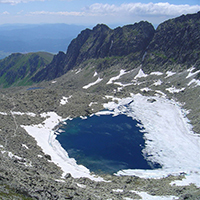Classification of the Tatra Mountain lakes in terms of the duration of their ice cover (Poland and Slovakia)
Ice cover classification of the Tatra Mountain lakes

Submitted: 17 June 2019
Accepted: 27 November 2019
Published: 11 December 2019
Accepted: 27 November 2019
Abstract Views: 900
PDF: 443
HTML: 41
HTML: 41
Publisher's note
All claims expressed in this article are solely those of the authors and do not necessarily represent those of their affiliated organizations, or those of the publisher, the editors and the reviewers. Any product that may be evaluated in this article or claim that may be made by its manufacturer is not guaranteed or endorsed by the publisher.
All claims expressed in this article are solely those of the authors and do not necessarily represent those of their affiliated organizations, or those of the publisher, the editors and the reviewers. Any product that may be evaluated in this article or claim that may be made by its manufacturer is not guaranteed or endorsed by the publisher.
Similar Articles
- Valentina PIERI, Koen MARTENS, Fabio STOCH, Giampaolo ROSSETTI, Distribution and ecology of non-marine ostracods (Crustacea, Ostracoda) from Friuli Venezia Giulia (NE Italy) , Journal of Limnology: Vol. 68 No. 1 (2009)
- Mitchell M. McFATTER, Harry A. MEYER, Juliana G. HINTON, Nearctic freshwater tardigrades: a review , Journal of Limnology: Vol. 66 No. s1 (2007): 10th International Symposium on Tardigrada
- Florencia CUASSOLO, Marcela BASTIDAS NAVARRO, Esteban BALSEIRO, Beatriz MODENUTTI, Leachates and elemental ratios of macrophytes and benthic algae of an Andean high altitude wetland , Journal of Limnology: Vol. 70 No. 2 (2011)
- Barbara PIETRZAK, Interclonal differences in age-specific performance in Daphnia magna , Journal of Limnology: Vol. 70 No. 2 (2011)
- Leonardo CASTELLANO, Walter AMBROSETTI, Luigi BARBANTI, Angelo ROLLA, The residence time of the water in Lago Maggiore (N. Italy): first results from an Eulerian-Lagrangian approach , Journal of Limnology: Vol. 69 No. 1 (2010)
- Gianluca CORNO, Emanuele CARAVATI, Cristiana CALLIERI, Roberto BERTONI, Effects of predation pressure on bacterial abundance, diversity, and size-structure distribution in an oligotrophic system , Journal of Limnology: Vol. 67 No. 2 (2008)
- Rossana D'ADDABBO, Maria GALLO, Cristiana DE LEONARDIS, Roberto SANDULLI, Susanna DE ZIO GRIMALDI, Further studies on the marine tardigrade fauna from Sardinia (Italy) , Journal of Limnology: Vol. 66 No. s1 (2007): 10th International Symposium on Tardigrada
- Bimalendu B. Nath, Extracellular hemoglobin and environmental stress tolerance in Chironomus larvae , Journal of Limnology: Vol. 77 No. s1 (2018): Recent advances in the study of Chironomidae: An overview
- Paola ZARATTINI, Intraspecific differences in hatching phenology of the fairy shrimp Chirocephalus diaphanus Prévost, 1803 (Crustacea, Anostraca) in relation to habitat duration , Journal of Limnology: Vol. 63 No. s1 (2004): Diapause In Aquatic Invertebrates
- Francesco ALIANIELLO, Francesco A. BIONDI, Cinzia FERRARI, Girolamo MECELLA, Luigi NISINI, Forest soil conditions in the CONECOFOR Permanent Monitoring Plots and in the Level I Network in Italy , Journal of Limnology: Vol. 61 No. s1 (2002): National Programme for Forest Ecosystems Control CONECOFOR
<< < 82 83 84 85 86 87 88 89 90 91 > >>
You may also start an advanced similarity search for this article.

 https://doi.org/10.4081/jlimnol.2019.1920
https://doi.org/10.4081/jlimnol.2019.1920





